

Compact Muon Solenoid
LHC, CERN
| CMS-PAS-EXO-16-032 | ||
| Search for narrow resonances decaying to dijets in pp collisions at $\sqrt{s}=$ 13 TeV using 12.9 fb$^{-1}$ | ||
| CMS Collaboration | ||
| August 2016 | ||
| Abstract: A search is presented for narrow resonances decaying to dijet final states in proton-proton collisions at $\sqrt{s}=$ 13 TeV from an integrated luminosity of 12.9 fb$^{-1}$. Results are presented for two searches. A low-mass search, for a resonance mass between 0.6 TeV and 1.6 TeV, is performed using dijets that are reconstructed from calorimeter information in the high-level trigger. A high-mass search, for resonances with mass above 1.6 TeV, is performed using dijets reconstructed with the particle flow algorithm from the normal reconstruction chain. The pseudorapidity separation of the two jets is required to satisfy $|\Delta\eta_{\text{jj}}|< $ 1.3 with each jet inside the region $|\eta| < $ 2.5. The spectra are well described by a smooth parameterization and no significant evidence for new particle production is observed. Upper limits at 95% confidence level are reported on the production cross section times branching ratio to dijets times acceptance of the $|\Delta\eta_{\text{jj}}|$ and $|\eta|$ cuts for narrow resonances from quark-quark, quark-gluon and gluon-gluon final states. When interpreted in the context of specific models, the limits exclude string resonances with masses below 7.4 TeV, scalar diquarks below 6.9 TeV, axigluons and colorons below 5.5 TeV, excited quarks below 5.4 TeV, color-octet scalars below 3.0TeV, W' bosons below 2.7 TeV, Z' bosons below 2.1 TeV and between 2.3 to 2.6 TeV, and RS gravitons below 1.9 TeV, extending previously published limits in the dijet channel. | ||
|
Links:
CDS record (PDF) ;
inSPIRE record ;
CADI line (restricted) ;
These preliminary results are superseded in this paper, PLB 769 (2017) 520. The superseded preliminary plots can be found here. |
||
| Figures & Tables | Summary | Additional Figures & Tables | References | CMS Publications |
|---|
| Figures | |
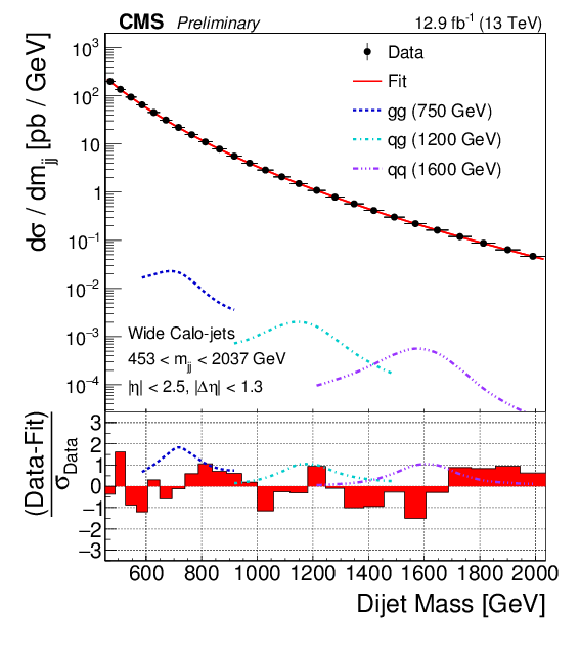
png pdf |
Figure 1-a:
Dijet mass spectrum (points) compared to a fitted parameterization of the background (solid curve) for the low-mass search (a) and the high-mass search (b). The lower panel in each plot shows the difference between the data and the fitted parametrization, divided by the statistical uncertainty of the data. Predicted signals from narrow gluon-gluon, quark-gluon, and quark-quark resonances are shown with cross section equal to the observed upper limit at 95% CL. |

png pdf |
Figure 1-b:
Dijet mass spectrum (points) compared to a fitted parameterization of the background (solid curve) for the low-mass search (a) and the high-mass search (b). The lower panel in each plot shows the difference between the data and the fitted parametrization, divided by the statistical uncertainty of the data. Predicted signals from narrow gluon-gluon, quark-gluon, and quark-quark resonances are shown with cross section equal to the observed upper limit at 95% CL. |
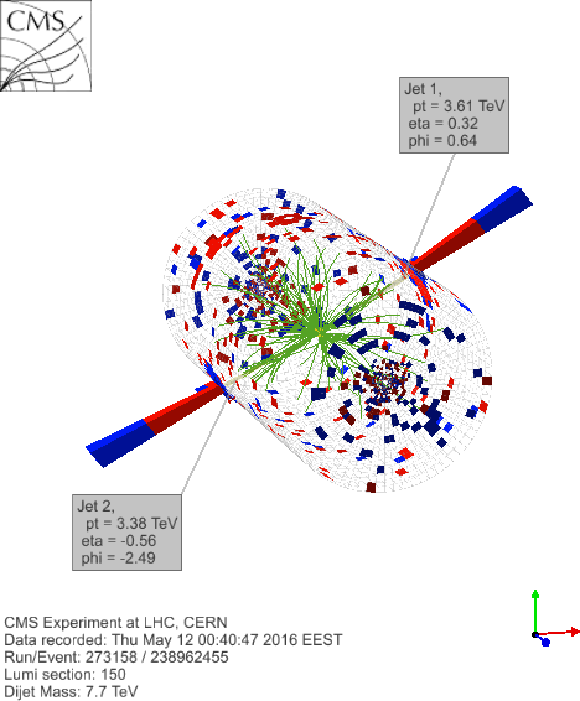
png |
Figure 2-a:
The event with the highest dijet invariant mass: three dimensional view (a), 2D view in the $\rho $-$\phi $ plane (b). The ${p_{\mathrm {T}}} $, $\eta $, and $\phi $ values of the two wide jets are indicated. The invariant mass of the two wide jets is 7.7 TeV . |
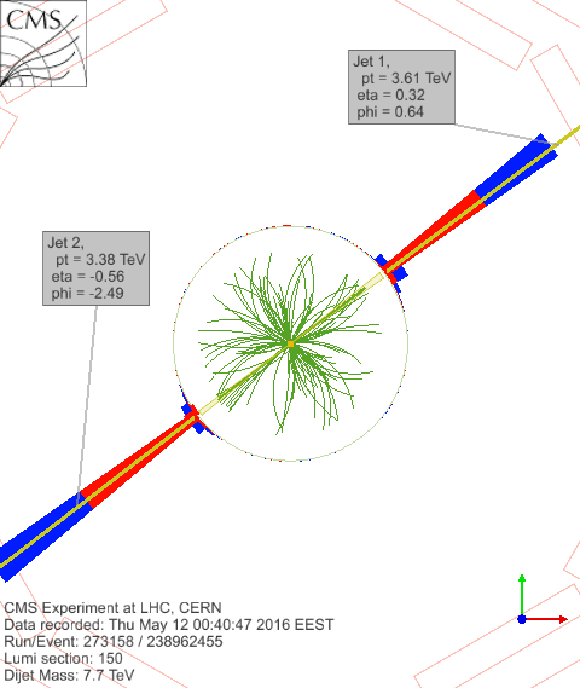
png |
Figure 2-b:
The event with the highest dijet invariant mass: three dimensional view (a), 2D view in the $\rho $-$\phi $ plane (b). The ${p_{\mathrm {T}}} $, $\eta $, and $\phi $ values of the two wide jets are indicated. The invariant mass of the two wide jets is 7.7 TeV . |
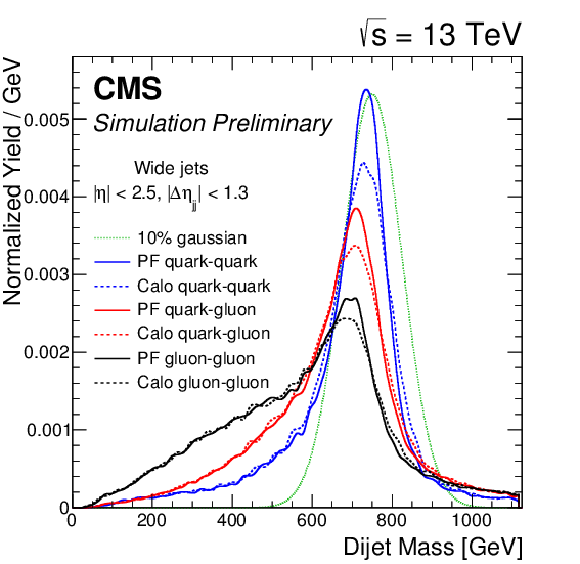
png pdf |
Figure 3-a:
The reconstructed resonance mass spectrum predicted by the PYTHIA-8 MC event generator including simulation of the detector. Resonances from quark-quark processes modeled by $ {\mathrm {q}} {\overline {\mathrm {q}}} \to {\mathrm {G}} \to {\mathrm {q}} {\overline {\mathrm {q}}} $ (blue), quark-gluon processes modeled by $ {\mathrm {q}} {\mathrm {g}} \to { {\mathrm {q}} ^*} \to {\mathrm {q}} {\mathrm {g}} $ (red), and gluon-gluon processes modeled by $ {\mathrm {g}} {\mathrm {g}} \to {\mathrm {G}} \to {\mathrm {g}} {\mathrm {g}} $ (black), where ${\mathrm {G}}$ is an RS graviton and ${ {\mathrm {q}} ^*}$ is an excited quark. (a) Resonances generated with a mass of 750 GeV are shown for wide jets from PF-jet reconstruction (solid) and calo-jet reconstruction (dashed). Also shown is a hypothetical Gaussian shape (dotted green) with a mean mass of 750 GeV and an RMS width equal to 10% of the mean mass. (b) Resonances generated with a mass of 1, 3, 5 and 7 TeV are shown for wide jets from PF-jet reconstruction. |
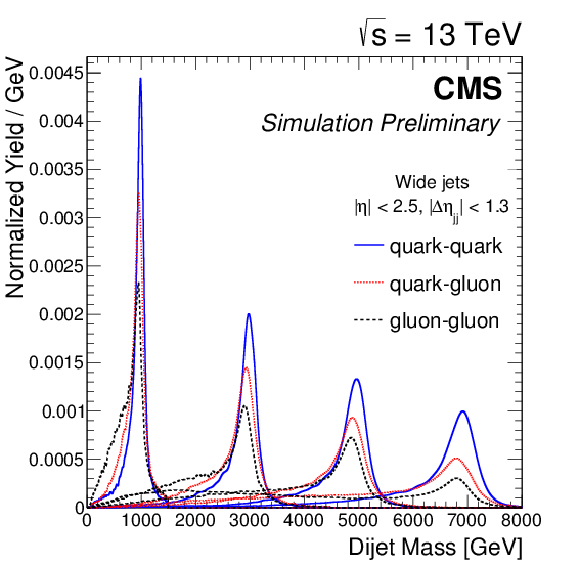
png pdf |
Figure 3-b:
The reconstructed resonance mass spectrum predicted by the PYTHIA-8 MC event generator including simulation of the detector. Resonances from quark-quark processes modeled by $ {\mathrm {q}} {\overline {\mathrm {q}}} \to {\mathrm {G}} \to {\mathrm {q}} {\overline {\mathrm {q}}} $ (blue), quark-gluon processes modeled by $ {\mathrm {q}} {\mathrm {g}} \to { {\mathrm {q}} ^*} \to {\mathrm {q}} {\mathrm {g}} $ (red), and gluon-gluon processes modeled by $ {\mathrm {g}} {\mathrm {g}} \to {\mathrm {G}} \to {\mathrm {g}} {\mathrm {g}} $ (black), where ${\mathrm {G}}$ is an RS graviton and ${ {\mathrm {q}} ^*}$ is an excited quark. (a) Resonances generated with a mass of 750 GeV are shown for wide jets from PF-jet reconstruction (solid) and calo-jet reconstruction (dashed). Also shown is a hypothetical Gaussian shape (dotted green) with a mean mass of 750 GeV and an RMS width equal to 10% of the mean mass. (b) Resonances generated with a mass of 1, 3, 5 and 7 TeV are shown for wide jets from PF-jet reconstruction. |
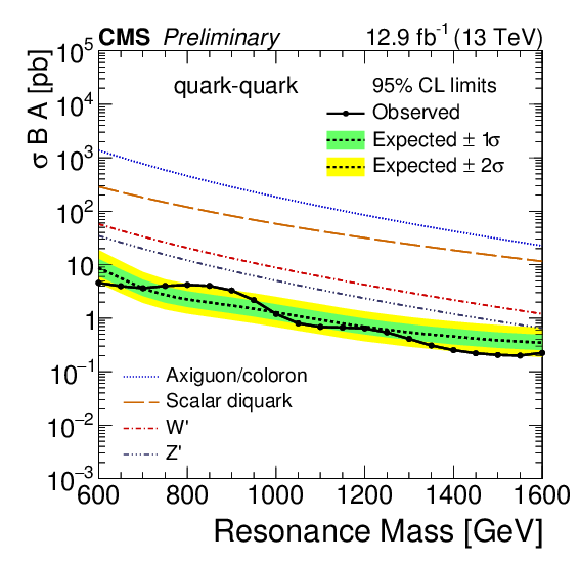
png pdf |
Figure 4-a:
Limits from the low-mass search. The observed 95% CL upper limits on the product of the cross section, branching fraction, and acceptance for quark-quark (a), quark-gluon (b), and gluon-gluon (c) type dijet resonances. The corresponding expected limits (dashed) and their variation at the 1 and 2 standard deviation levels (shaded bands) are also shown. (bottom right) The observed limits (solid) are summarized for fully simulated shapes from all three physical types of resonances along with the limit for a hypothetical Gaussian shape with RMS width equal to 10% of the mean mass. Limits are compared to the predicted cross sections of excited quarks [24,25], axigluons [21], colorons [23], scalar diquarks [20], RS gravitons [28], and new gauge bosons W' and Z' [27]. |
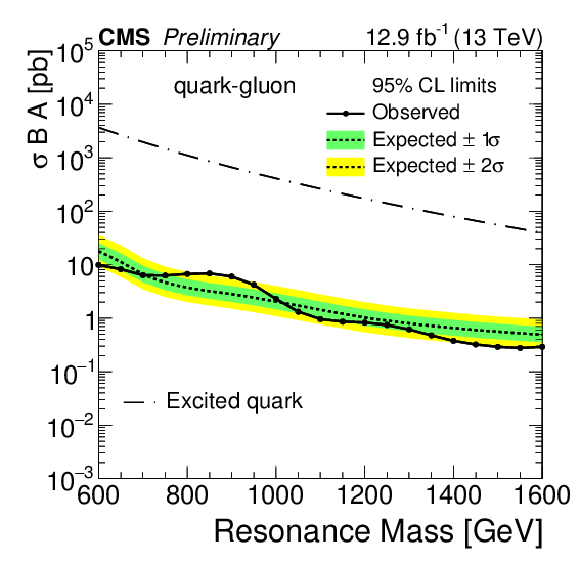
png pdf |
Figure 4-b:
Limits from the low-mass search. The observed 95% CL upper limits on the product of the cross section, branching fraction, and acceptance for quark-quark (a), quark-gluon (b), and gluon-gluon (c) type dijet resonances. The corresponding expected limits (dashed) and their variation at the 1 and 2 standard deviation levels (shaded bands) are also shown. (bottom right) The observed limits (solid) are summarized for fully simulated shapes from all three physical types of resonances along with the limit for a hypothetical Gaussian shape with RMS width equal to 10% of the mean mass. Limits are compared to the predicted cross sections of excited quarks [24,25], axigluons [21], colorons [23], scalar diquarks [20], RS gravitons [28], and new gauge bosons W' and Z' [27]. |
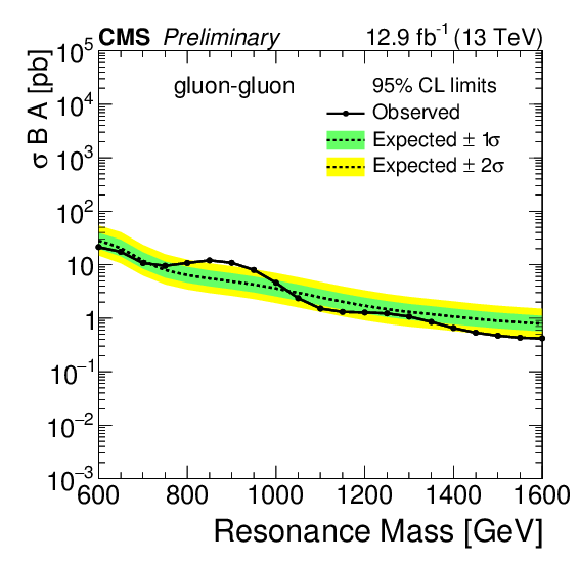
png pdf |
Figure 4-c:
Limits from the low-mass search. The observed 95% CL upper limits on the product of the cross section, branching fraction, and acceptance for quark-quark (a), quark-gluon (b), and gluon-gluon (c) type dijet resonances. The corresponding expected limits (dashed) and their variation at the 1 and 2 standard deviation levels (shaded bands) are also shown. (bottom right) The observed limits (solid) are summarized for fully simulated shapes from all three physical types of resonances along with the limit for a hypothetical Gaussian shape with RMS width equal to 10% of the mean mass. Limits are compared to the predicted cross sections of excited quarks [24,25], axigluons [21], colorons [23], scalar diquarks [20], RS gravitons [28], and new gauge bosons W' and Z' [27]. |
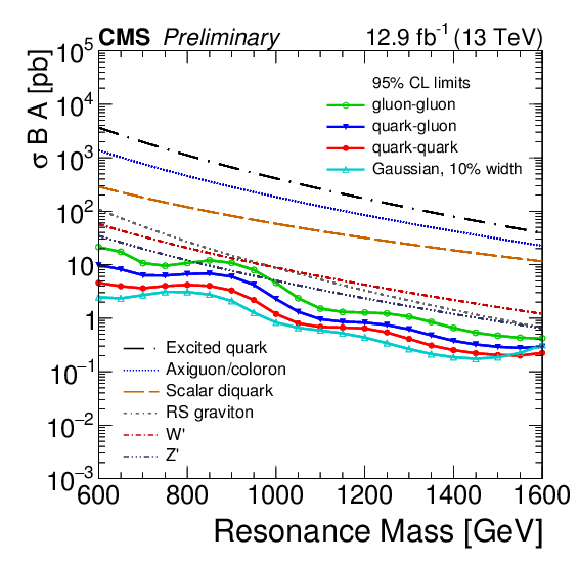
png pdf |
Figure 4-d:
Limits from the low-mass search. The observed 95% CL upper limits on the product of the cross section, branching fraction, and acceptance for quark-quark (a), quark-gluon (b), and gluon-gluon (c) type dijet resonances. The corresponding expected limits (dashed) and their variation at the 1 and 2 standard deviation levels (shaded bands) are also shown. (bottom right) The observed limits (solid) are summarized for fully simulated shapes from all three physical types of resonances along with the limit for a hypothetical Gaussian shape with RMS width equal to 10% of the mean mass. Limits are compared to the predicted cross sections of excited quarks [24,25], axigluons [21], colorons [23], scalar diquarks [20], RS gravitons [28], and new gauge bosons W' and Z' [27]. |
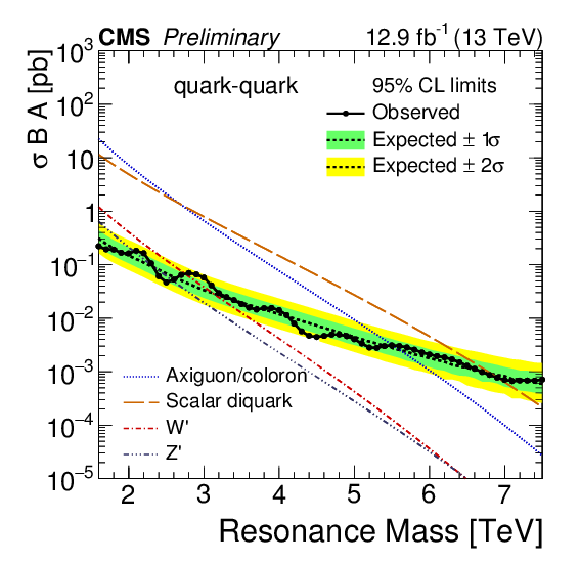
png pdf |
Figure 5-a:
Limits from the high-mass search. The observed 95% CL upper limits on the product of the cross section, branching fraction, and acceptance for quark-quark (a), quark-gluon (b), and gluon-gluon (c) type dijet resonances. The corresponding expected limits (dashed) and their variation at the 1 and 2 standard deviation levels (shaded bands) are also shown. (d) The observed limits (solid) are summarized. Limits are compared to the predicted cross sections of string resonances [18,19], excited quarks [24,25], axigluons [21], colorons [23], scalar diquarks [20], color-octet scalars [26], new gauge bosons W' and Z' [27], and RS gravitons [28]. |
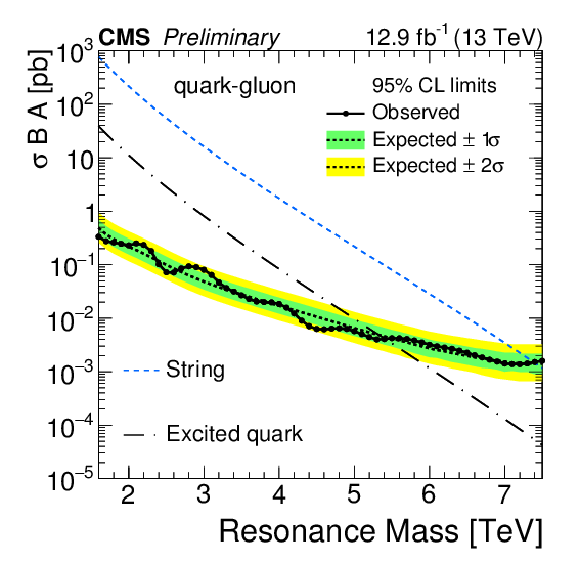
png pdf |
Figure 5-b:
Limits from the high-mass search. The observed 95% CL upper limits on the product of the cross section, branching fraction, and acceptance for quark-quark (a), quark-gluon (b), and gluon-gluon (c) type dijet resonances. The corresponding expected limits (dashed) and their variation at the 1 and 2 standard deviation levels (shaded bands) are also shown. (d) The observed limits (solid) are summarized. Limits are compared to the predicted cross sections of string resonances [18,19], excited quarks [24,25], axigluons [21], colorons [23], scalar diquarks [20], color-octet scalars [26], new gauge bosons W' and Z' [27], and RS gravitons [28]. |

png pdf |
Figure 5-c:
Limits from the high-mass search. The observed 95% CL upper limits on the product of the cross section, branching fraction, and acceptance for quark-quark (a), quark-gluon (b), and gluon-gluon (c) type dijet resonances. The corresponding expected limits (dashed) and their variation at the 1 and 2 standard deviation levels (shaded bands) are also shown. (d) The observed limits (solid) are summarized. Limits are compared to the predicted cross sections of string resonances [18,19], excited quarks [24,25], axigluons [21], colorons [23], scalar diquarks [20], color-octet scalars [26], new gauge bosons W' and Z' [27], and RS gravitons [28]. |
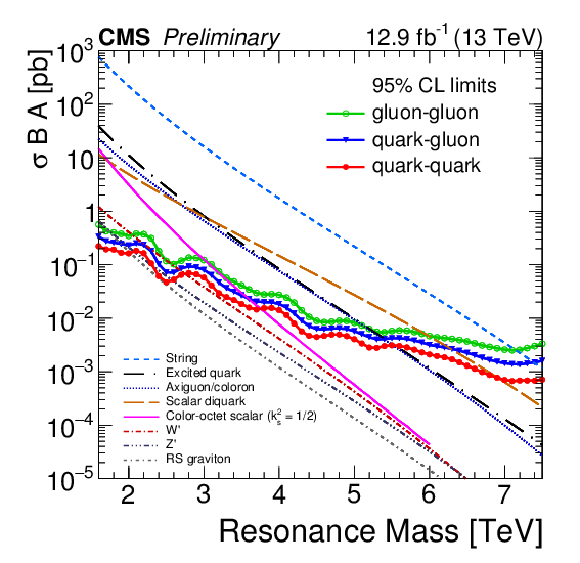
png pdf |
Figure 5-d:
Limits from the high-mass search. The observed 95% CL upper limits on the product of the cross section, branching fraction, and acceptance for quark-quark (a), quark-gluon (b), and gluon-gluon (c) type dijet resonances. The corresponding expected limits (dashed) and their variation at the 1 and 2 standard deviation levels (shaded bands) are also shown. (d) The observed limits (solid) are summarized. Limits are compared to the predicted cross sections of string resonances [18,19], excited quarks [24,25], axigluons [21], colorons [23], scalar diquarks [20], color-octet scalars [26], new gauge bosons W' and Z' [27], and RS gravitons [28]. |

png pdf |
Figure 6:
Limits from both the low-mass and high-mass search. The observed 95% CL upper limits on the product of the cross section, branching fraction, and acceptance for quark-quark, quark-gluon, and gluon-gluon type dijet resonances. The observed limits (solid) are presented from the low mass search, for resonance masses between 0.6 TeV and 1.6 TeV , and from the high mass search for resonance masses greater than or equal to 1.6 TeV . Limits are compared to the predicted cross sections of string resonances [18,19], excited quarks [24,25], axigluons [21], colorons [23], scalar diquarks [20], color-octet scalars [26], new gauge bosons W' and Z' [27], and RS gravitons [28]. |
| Tables | |
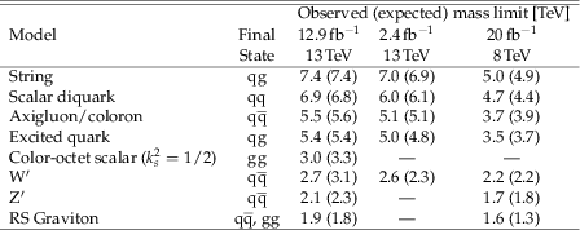
png pdf |
Table 1:
Observed and expected mass limits at 95% CL from this analysis with 12.9 fb$^{-1}$ at $\sqrt {s}=$ 13 TeV compared to previously published limits on narrow resonances from CMS with 2.4 fb$^{-1}$ at $\sqrt {s}=$ 13 TeV [3] and with 20 fb$^{-1}$ at $\sqrt {s}=$ 8 TeV [9]. The listed models are excluded between 0.6 TeV and the indicated mass limit by this analysis. For the Z' model, in addition to the observed mass limit listed below, this analysis also excludes the mass interval between 2.3 and 2.6 TeV . |
| Summary |
| In summary, two searches for narrow resonances decaying into a pair of jets have been performed using pp collisions at $\sqrt{s}=$ 13 TeV corresponding to an integrated luminosity of 12.9 fb$^{-1}$. A low-mass search using data scouting from the HLT trigger with calorimeter jets and a high-mass search using particle flow jets. The dijet mass spectra have been measured to be smoothly falling distributions. In the analyzed data samples, there is no evidence for resonant particle production. We present generic upper limits on the product $\sigma\, B\, A$ for narrow quark-quark, quark-gluon and gluon-gluon resonances that are applicable to any model of narrow dijet resonance production. We set mass limits at 95% CL on models of string resonances, scalar diquarks, excited quarks, axigluons, colorons, color octet scalars, W' bosons, Z' bosons, and RS gravitons, which extend previously published limits in the dijet channel. |
| Additional Figures | |
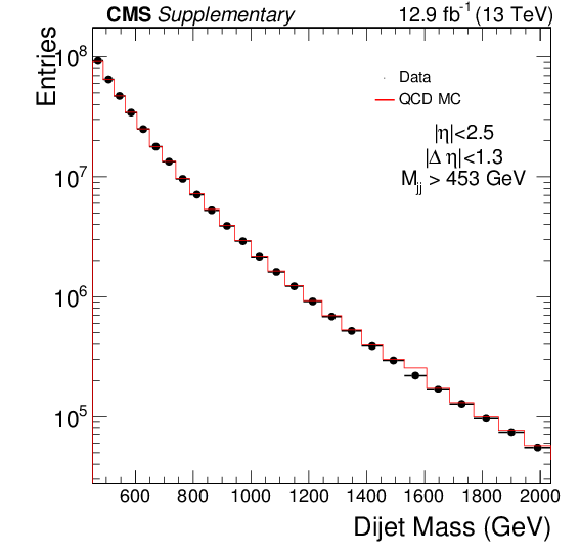
png pdf |
Additional Figure 1:
The dijet mass of the two wide jets after all selection criteria are applied, for data from the low-mass search (points) and {{pythia} 8} MC with detector simulation (histogram) normalized to the data. |
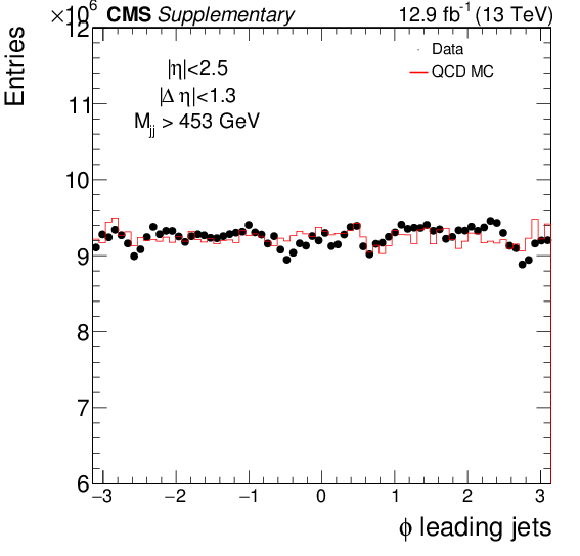
png pdf |
Additional Figure 2:
The azimuthal angle of the two wide jets after all selection criteria are applied, for data from the low-mass search (points) and {{pythia} 8} MC with detector simulation (histogram) normalized to the data. |
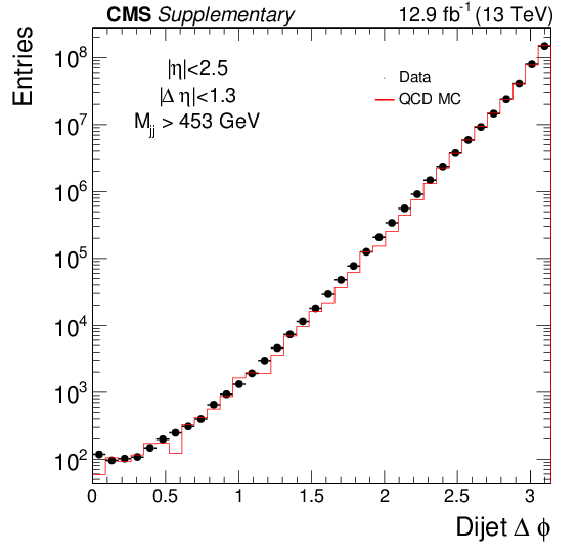
png pdf |
Additional Figure 3:
The azimuthal angular separation between the two wide-jets after all selection criteria are applied, for data from the low-mass search (points) and {{pythia} 8} MC with detector simulation (histogram) normalized to the data. |
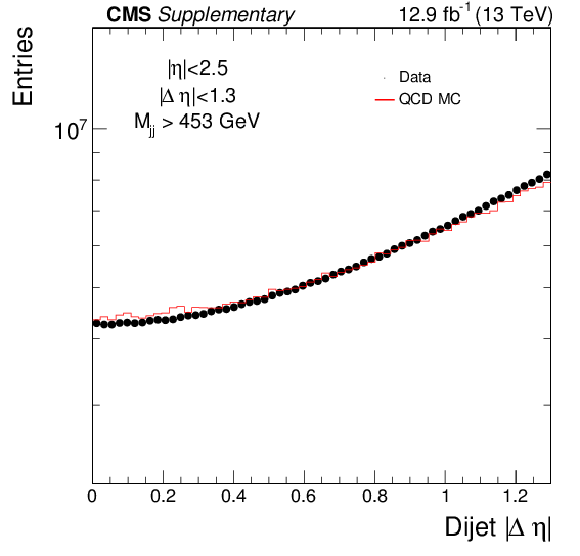
png pdf |
Additional Figure 4:
The absolute difference in pseudorapidity between the two wide-jets after all selection criteria are applied, for data from the low-mass search (points) and {{pythia} 8} MC with detector simulation (histogram) normalized to the data. |
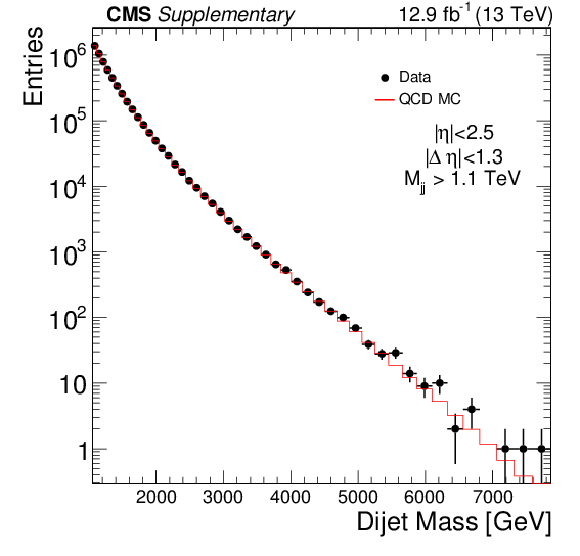
png pdf |
Additional Figure 5:
The dijet mass of the two wide jets after all selection criteria are applied, for data from the high-mass search (points) and {{pythia} 8} MC with detector simulation (histogram) normalized to the data. |

png pdf |
Additional Figure 6:
The azimuthal angle of the two wide jets after all selection criteria are applied, for data from the high-mass search (points) and {{pythia} 8} MC with detector simulation (histogram) normalized to the data. |
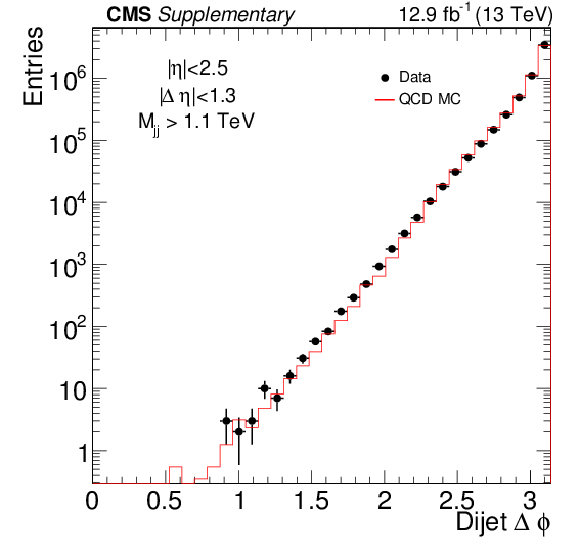
png pdf |
Additional Figure 7:
The azimuthal angular separation between the two wide-jets after all selection criteria are applied, for data from the high-mass search (points) and {{pythia} 8} MC with detector simulation (histogram) normalized to the data. |
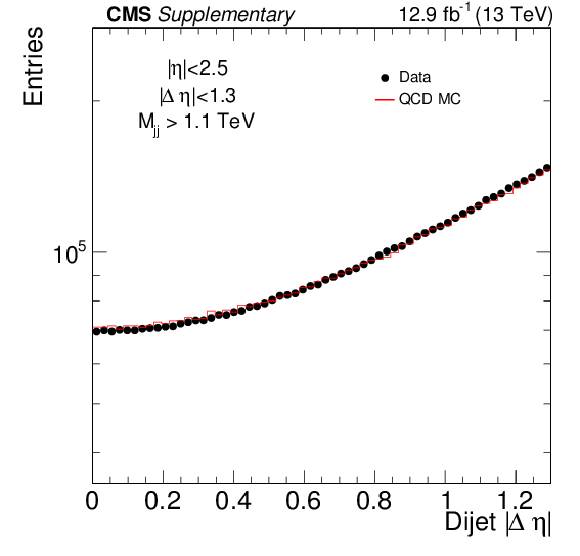
png pdf |
Additional Figure 8:
The absolute difference in pseudorapidity between the two wide-jets after all selection criteria are applied, for data from the high-mass search (points) and {{pythia} 8} MC with detector simulation (histogram) normalized to the data. |
| Additional Tables | |
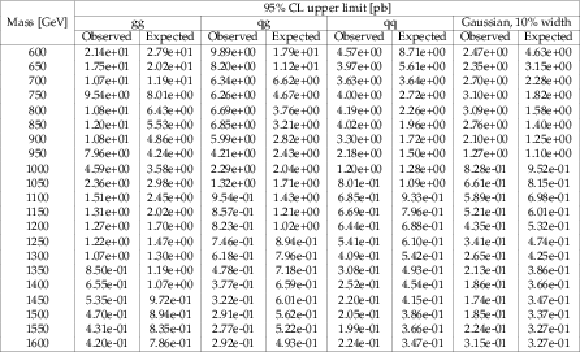
png pdf |
Additional Table 1:
Limits from the low-mass search. Observed and expected upper limits at 95% CL on $\sigma \times B \times A$ for a $\mathrm{g} \mathrm{g} $ resonance, a $\mathrm{ q } \mathrm{g} $ resonance, a $\mathrm{ q } \mathrm{ q } $ resonance, and a 10% Gaussian lineshape as a function of the resonance mass. |

png pdf |
Additional Table 2:
Limits from the high-mass search. Observed and expected upper limits at 95% CL on $\sigma \times B \times A$ for a $\mathrm{g} \mathrm{g} $ resonance, a $\mathrm{ q } \mathrm{g} $ resonance, and a $\mathrm{ q } \mathrm{ q } $ resonance as a function of the resonance mass. |
| References | ||||
| 1 | CMS Collaboration | Search for narrow resonances in dijet final states at $ \sqrt(s)= $ 8 TeV with the novel CMS technique of data scouting | PRL 117 (2016), no. 3, 031802 | CMS-EXO-14-005 1604.08907 |
| 2 | ATLAS Collaboration | Search for light dijet resonances with the ATLAS detector using a Trigger-Level Analysis in LHC pp collisions at $ \sqrt{s}=13 $~TeV | ATLAS Conference Report ATLAS-CONF-2016-030, Jun | |
| 3 | CMS Collaboration | Search for narrow resonances decaying to dijets in proton-proton collisions at $ \sqrt{s} = $ 13 TeV | PRL 116 (2016) 071801 | CMS-EXO-15-001 1512.01224 |
| 4 | ATLAS Collaboration | Search for new phenomena in dijet mass and angular distributions from $ pp $ collisions at $ \sqrt{s}= $ 13 TeV with the ATLAS detector | PLB754 (2016) 302--322 | 1512.01530 |
| 5 | CMS Collaboration | Search for Dijet Resonances in 7 TeV pp Collisions at CMS | PRL 105 (2010) 211801, , [Erratum \DOI10.1103/PhysRevLett.106.029902] | CMS-EXO-10-010 1010.0203 |
| 6 | CMS Collaboration | Search for resonances in the dijet mass spectrum from 7 TeV pp collisions at CMS | PLB 704 (2011) 123 | CMS-EXO-11-015 1107.4771 |
| 7 | CMS Collaboration | Search for narrow resonances and quantum black holes in inclusive and $ b $-tagged dijet mass spectra from pp collisions at $ \sqrt{s}=7 $ TeV | JHEP 01 (2013) 013 | CMS-EXO-11-094 1210.2387 |
| 8 | CMS Collaboration | Search for narrow resonances using the dijet mass spectrum in $ pp $ collisions at $ \sqrt{s} $ = 8 TeV | PRD 87 (2013) 114015 | CMS-EXO-12-016 1302.4794 |
| 9 | CMS Collaboration | Search for resonances and quantum black holes using dijet mass spectra in proton-proton collisions at $ \sqrt{s} = 8 $ TeV | PRD 91 (2015) 052009 | CMS-EXO-12-059 1501.04198 |
| 10 | ATLAS Collaboration | Search for New Particles in Two-Jet Final States in 7 TeV Proton-Proton Collisions with the ATLAS Detector at the LHC | PRL 105 (2010) 161801 | 1008.2461 |
| 11 | ATLAS Collaboration | Search for new physics in dijet mass and angular distributions in $ pp $ collisions at $ \sqrt{s} = 7 $ TeV measured with the ATLAS detector | New J. Phys. 13 (2011) 053044 | 1103.3864 |
| 12 | ATLAS Collaboration | Search for new physics in the dijet mass distribution using 1 fb$ ^{-1} $ of $ pp $ collision data at $ \sqrt{s} $ = 7 TeV collected by the ATLAS detector | PLB 708 (2012) 37 | 1108.6311 |
| 13 | ATLAS Collaboration | ATLAS search for new phenomena in dijet mass and angular distributions using $ pp $ collisions at $ \sqrt{s}=7 $ TeV | JHEP 01 (2013) 029 | 1210.1718 |
| 14 | ATLAS Collaboration | Search for new phenomena in the dijet mass distribution using $ pp $ collision data at $ \sqrt{s}=8 $ TeV with the ATLAS detector | PRD 91 (2015) 052007 | 1407.1376 |
| 15 | R. M. Harris and K. Kousouris | Searches for dijet resonances at hadron colliders | Int. J. Mod. Phys. A 26 (2011) 5005 | 1110.5302 |
| 16 | CMS Collaboration | Particle--Flow Event Reconstruction in CMS and Performance for Jets, Taus, and $ E_{\mathrm{T}}^{\text{miss}} $ | CDS | |
| 17 | CMS Collaboration | Commissioning of the Particle-flow Event Reconstruction with the first LHC collisions recorded in the CMS detector | CDS | |
| 18 | L. A. Anchordoqui et al. | Dijet Signals for Low Mass Strings at the LHC | PRL 101 (2008) 241803 | 0808.0497 |
| 19 | S. Cullen, M. Perelstein, and M. E. Peskin | TeV strings and collider probes of large extra dimensions | PRD 62 (2000) 055012 | hep-ph/0001166 |
| 20 | J. L. Hewett and T. G. Rizzo | Low-energy phenomenology of superstring-inspired E(6) models | PR 183 (1989) 193 | |
| 21 | P. H. Frampton and S. L. Glashow | Chiral Color: An Alternative to the Standard Model | PLB 190 (1987) 157 | |
| 22 | R. S. Chivukula, E. H. Simmons, A. Farzinnia, and J. Ren | Hadron collider production of massive color-octet vector bosons at next-to-leading order | PRD 87 (2013) 094011 | 1303.1120 |
| 23 | E. H. Simmons | Coloron phenomenology | PRD 55 (1997) 1678 | hep-ph/9608269 |
| 24 | U. Baur, I. Hinchliffe, and D. Zeppenfeld | Excited Quark Production at Hadron Colliders | Int. J. Mod. Phys. A 02 (1987) 1285 | |
| 25 | U. Baur, M. Spira, and P. M. Zerwas | Excited quark and lepton production at hadron colliders | PRD 42 (1990) 815 | |
| 26 | T. Han, I. Lewis, and Z. Liu | Colored resonant signals at the LHC: largest rate and simplest topology | JHEP 12 (2010) 085 | 1010.4309 |
| 27 | E. Eichten, I. Hinchliffe, K. D. Lane, and C. Quigg | Supercollider physics | Rev. Mod. Phys. 56 (1984) 579 | |
| 28 | L. Randall and R. Sundrum | An Alternative to compactification | PRL 83 (1999) 4690 | hep-th/9906064 |
| 29 | R. Sekhar Chivukula, E. H. Simmons, and N. Vignaroli | Distinguishing dijet resonances at the LHC | PRD91 (2015), no. 5, 055019 | 1412.3094 |
| 30 | CMS Collaboration | The CMS experiment at the CERN LHC | JINST 3 (2008) S08004 | CMS-00-001 |
| 31 | M. Cacciari, G. P. Salam, and G. Soyez | The Anti-$ k_t $ jet clustering algorithm | JHEP 04 (2008) 063 | 0802.1189 |
| 32 | M. Cacciari and G. P. Salam | Dispelling the $ N^{3} $ myth for the $ k_t $ jet-finder | PLB 641 (2006) 57 | hep-ph/0512210 |
| 33 | M. Cacciari, G. P. Salam, and G. Soyez | FastJet user manual | EPJC 72 (2012) 1896 | 1111.6097 |
| 34 | M. Cacciari and G. P. Salam | Pileup subtraction using jet areas | PLB 659 (2008) 119 | 0707.1378 |
| 35 | CMS Collaboration | Jet energy scale and resolution in the CMS experiment in pp collisions at 8 TeV | Submitted to JINST | CMS-JME-13-004 1607.03663 |
| 36 | CMS Collaboration | Jet Performance in pp Collisions at $ \sqrt{s} = 7 $ TeV | CDS | |
| 37 | CDF Collaboration | Search for new particles decaying into dijets in proton-antiproton collisions at $ \sqrt{s} = 1.96 $~TeV | PRD 79 (2009) 112002 | 0812.4036 |
| 38 | T. Sj\"ostrand, S. Mrenna, and P. Skands | A brief introduction to PYTHIA 8.1 | Comp. Phys. Comm. 178 (2008) 852 | 0710.3820 |
| 39 | T. Junk | Confidence level computation for combining searches with small statistics | Nucl. Instr. and Meth. A 434 (1999) 435 | hep-ex/9902006 |
| 40 | A. L. Read | Presentation of search results: the $ \rm CL_s $ technique | JPG 28 (2002) 2693 | |
| 41 | LHC Higgs Combination Group | Procedure for the LHC Higgs boson search combination in Summer 2011 | CMS-NOTE-2011-005 | |
| 42 | J. Pumplin et al. | New generation of parton distributions with uncertainties from global QCD analysis | JHEP 07 (2002) 012 | hep-ph/0201195 |

|
Compact Muon Solenoid LHC, CERN |

|

|

|

|

|

|